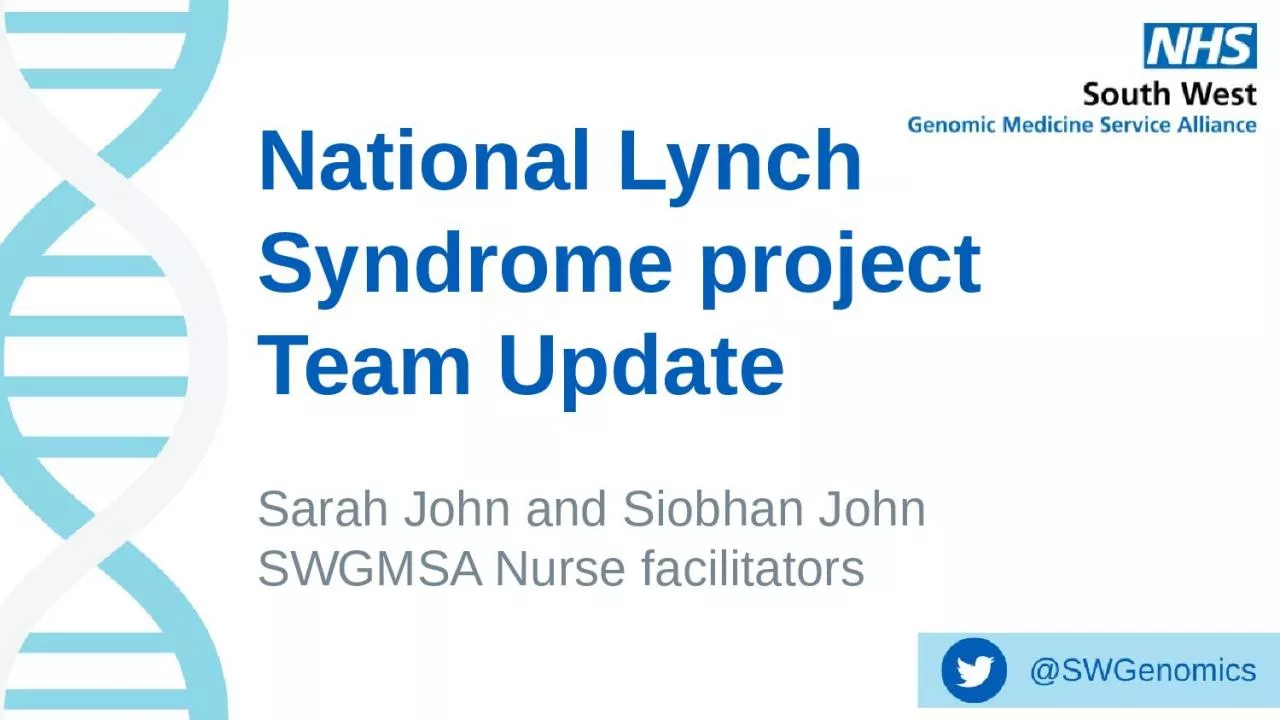

Sarah John and Siobhan John SWGMSA Nurse facilitators Why worry about Lynch A t least 260 endometrial cancers are caused by Lynch syndrome each year The Eve Appeal More than half of women with ID: 1041120
Download Presentation The PPT/PDF document "National Lynch Syndrome project Team Upd..." is the property of its rightful owner. Permission is granted to download and print the materials on this web site for personal, non-commercial use only, and to display it on your personal computer provided you do not modify the materials and that you retain all copyright notices contained in the materials. By downloading content from our website, you accept the terms of this agreement.
1. National Lynch Syndrome project Team UpdateSarah John and Siobhan John SWGMSA Nurse facilitators
2. Why worry about Lynch?At least 260 endometrial cancers are caused by Lynch syndrome each year (The Eve Appeal)More than half of women with metachronous colorectal and gynae cancers, present with endometrial 1st (Lu et al, 2005)175,000 people have Lynch syndrome in the UK, less than 5% know this (Bowel Cancer UK).NICE recommends testing at diagnosis
3. How does Lynch occur?A germline pathogenic mutation occurs in 1of 4 DNA mismatch repair genes resulting in a dMMR gene. It is autosomal dominant, so a child of a lynch parent has a 50:50 chance of inheriting the condition as well.
4. LS predisposes to certain cancer types:The main concerns are:Colorectal 20%-80% riskEndometrial 24% - 51% riskOther less frequent cancers: Ovarian 2%-17% (av 8%) Urinary tract 1%-18% Gastric 1%-13% Small intestine 1%-6% Hepato-biliary and pancreatic 1%-4%Sebaceous gland (and adenoma) 1%-2%Central Nervous System 1%-3%
5. Incidence of endometrial and ovarian cancersEndometrialOvarianNormal2%2%MLH134%11%MSH251%17%MSH649%11%PMS224%2%
6. When should we test?dMMR can affect cancer treatment options, certain tumours are more responsive to particular chemotherapy agents as well as new immunotherapy drugs called check point inhibitors. It is important that the initial tumour test is done in time to inform treatment options
7. How do checkpoint inhibitors work?Checkpoint proteins are found in T cells in our immune system.A cancer cell makes high levels of the proteins which switch off the T calls when the should be fighting cancer.Checkpoint inhibitors stop the proteins on the cancer cells from pushing the stop button.A GAME CHANGER!
8. Immunotherapy in Lynch Syndrome
9. Our RoleAudit the current provision in all trusts to highlight good and bad practiceSupport trusts to ensure patients are routinely tested for Lynch at diagnosis.Ensure patients are on the correct surveillance pathway and are added to the regional database.
10. Improving diagnostic pathways
11. https://rmpartners.nhs.uk/lynch-syndrome-early-diagnosis-pathway-endometrialSiobhan.John@nhs.netSarah.John@nbt.nhs.uk
12.